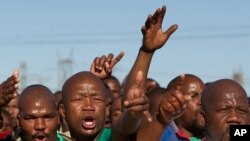MARIKANA —
In South Africa, August 16, 2012, will be remembered as the date of one of the country's most violent police confrontations since the apartheid era. Police shot dead 34 striking mineworkers at the Lonmin platinum mine in Marikana. The miners were striking to demand a significant pay raise and improved conditions. Officials say that since then, progress has been made: a commission is investigating the incident and the miners have been granted some raises. A year later, residents believe things have changed for the worse, not better.
Many South Africans said this scene reminded them of the apartheid days. Not since those dark days, they say, have they seen police shooting wildly into a crowd of black workers.
But this happened in 2012, when miners held an illegal strike at the Lonmin platinum mine in Marikana. They were led by the Association of Mineworkers and Construction Union, which challenged the powerful National Union of Mineworkers.
Police said that since last year, another 13 union members have been killed -- and that many of the slayings happened in broad daylight.
Just days before the one-year anniversary, Minister of Police Nathi Mthethwa visited the scene of a shooting of a female union representative, who was killed in front of her house.
Critics accuse police of not doing enough to solve the crimes, a charge Mthethwa disputes. “No, people have been arrested. And as you know, you must have your facts right, as you know, the Farlam Commission released people who police have tracked down and arrested, and those people are at large,” he explained.
Police spokesman Brigadier Thulani Ngubane said police have formed the Mine Crime Combating Forum, a joint initiative of police, unions and industry. “These are some of the efforts that are being put to ensure that labor, communities, the police in the forefront. We all work together to ensure that we bring the necessary peace and stability that is relevant in this area. And we also call the relevant citizens of this area to work with us,” he said.
Dozens of residents gave VOA near-identical accounts of being harassed and intimidated by union representatives.
But few would speak on camera, saying they feared they might be targeted by union-backed thugs.
The area was raided just days before by police, and residents said they don’t feel safe.
“Not at all," mineworker Sibongiseni Mibuzi said. "No, I’m not safe. Even the police don’t make me feel safe, because they come here at night and raid,” he said.
This mineworker said he constantly feels threatened.
“The security in this place is very poor. Police just show up, kick people’s doors in in the middle of the night," said mineworker Bangela Phathekile. "It is not safe at all. Our lives are at risk.”
A year later, there are few signs of the massive bloodshed that happened on this plain outside the mine.
These crosses, representing the shooting victims, were not here last year. But these 34 deaths are not the only ones that stain the ground of Marikana.
Many South Africans said this scene reminded them of the apartheid days. Not since those dark days, they say, have they seen police shooting wildly into a crowd of black workers.
But this happened in 2012, when miners held an illegal strike at the Lonmin platinum mine in Marikana. They were led by the Association of Mineworkers and Construction Union, which challenged the powerful National Union of Mineworkers.
Police said that since last year, another 13 union members have been killed -- and that many of the slayings happened in broad daylight.
Just days before the one-year anniversary, Minister of Police Nathi Mthethwa visited the scene of a shooting of a female union representative, who was killed in front of her house.
Critics accuse police of not doing enough to solve the crimes, a charge Mthethwa disputes. “No, people have been arrested. And as you know, you must have your facts right, as you know, the Farlam Commission released people who police have tracked down and arrested, and those people are at large,” he explained.
Police spokesman Brigadier Thulani Ngubane said police have formed the Mine Crime Combating Forum, a joint initiative of police, unions and industry. “These are some of the efforts that are being put to ensure that labor, communities, the police in the forefront. We all work together to ensure that we bring the necessary peace and stability that is relevant in this area. And we also call the relevant citizens of this area to work with us,” he said.
Dozens of residents gave VOA near-identical accounts of being harassed and intimidated by union representatives.
But few would speak on camera, saying they feared they might be targeted by union-backed thugs.
The area was raided just days before by police, and residents said they don’t feel safe.
“Not at all," mineworker Sibongiseni Mibuzi said. "No, I’m not safe. Even the police don’t make me feel safe, because they come here at night and raid,” he said.
This mineworker said he constantly feels threatened.
“The security in this place is very poor. Police just show up, kick people’s doors in in the middle of the night," said mineworker Bangela Phathekile. "It is not safe at all. Our lives are at risk.”
A year later, there are few signs of the massive bloodshed that happened on this plain outside the mine.
These crosses, representing the shooting victims, were not here last year. But these 34 deaths are not the only ones that stain the ground of Marikana.









